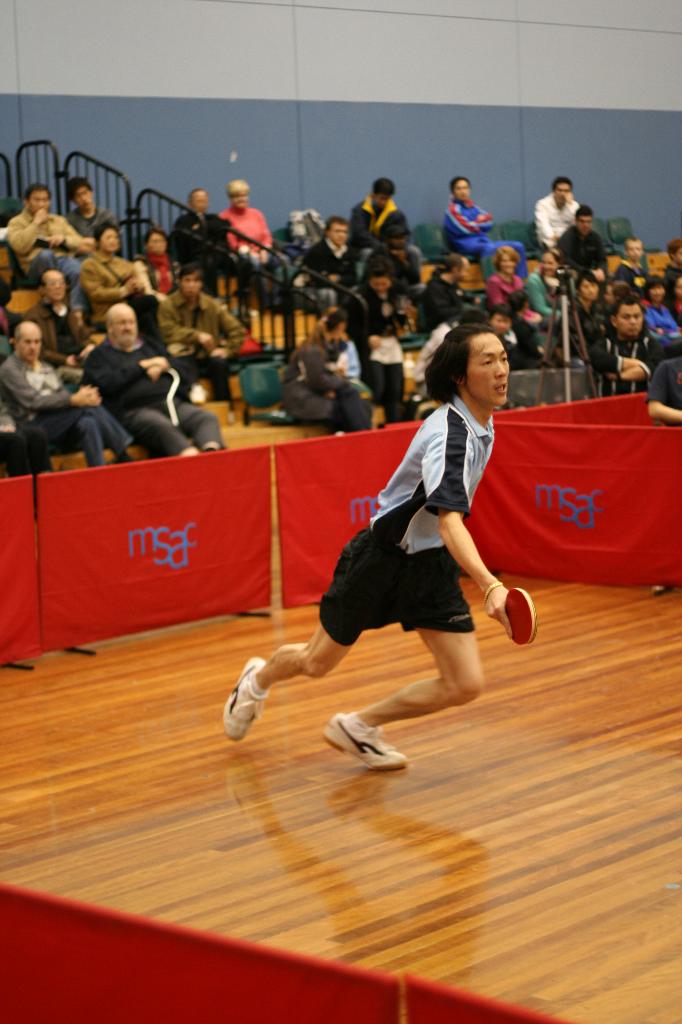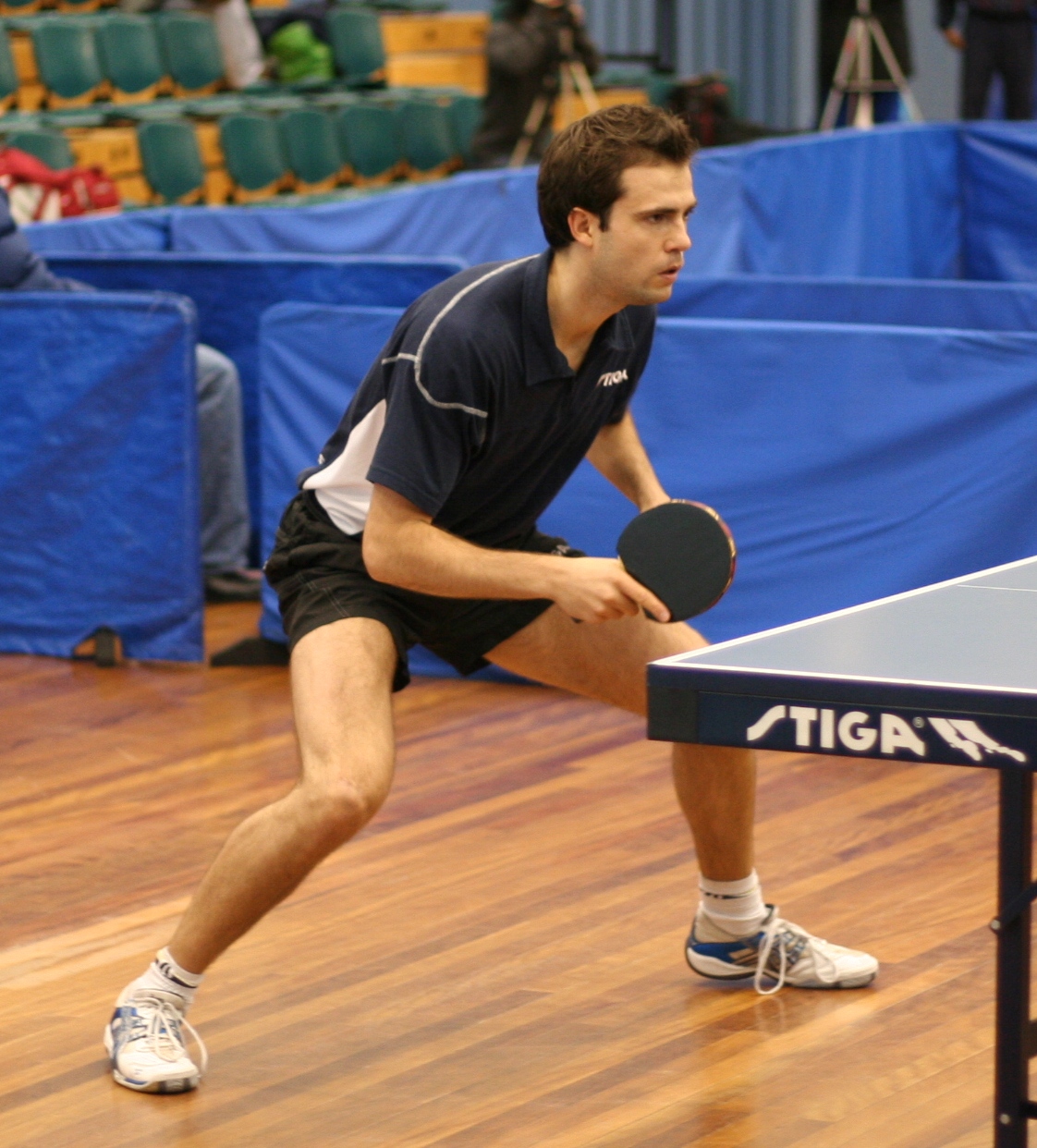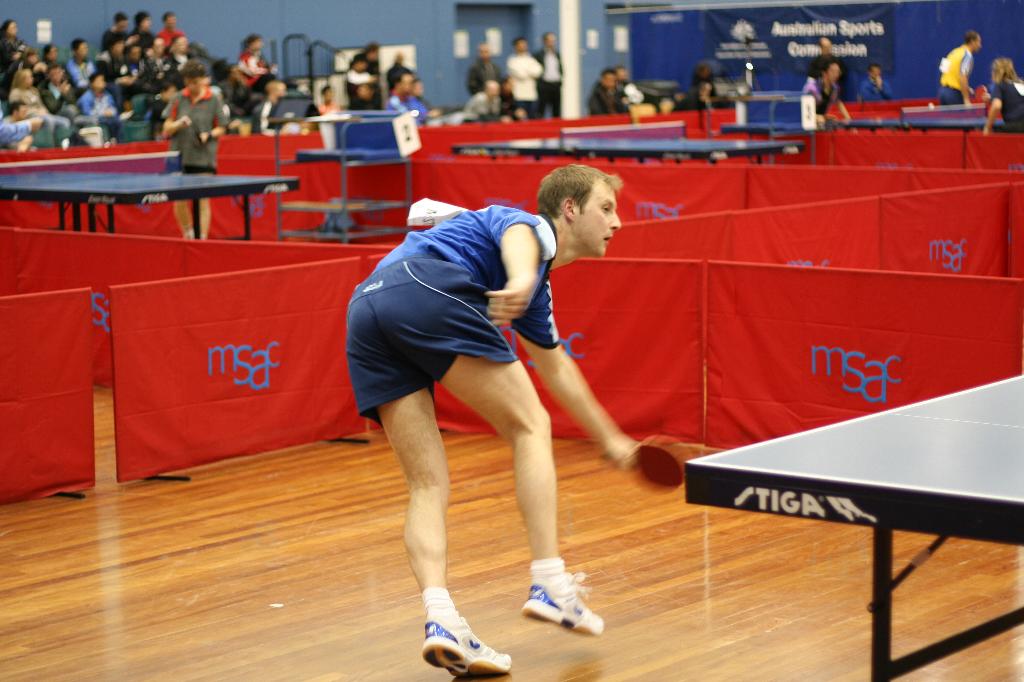You put your left foot in…

It is often difficult for beginners to learn to use the correct footwork. At the beginning, you can get away with poor footwork since it is not the most important part of the game. But as you get better having good footwork becomes more and more important, until it is an essential component of the game in advanced play.
Rather than starting out the wrong way and picking up bad habits that are hard to get rid of later, I’ll give you some simple tips that will put you on the right track for the future.
What is Good Footwork?
The point of using footwork is to get you to the ball so that you can hit the same stroke as much as possible. Good footwork allows you to consistently use your best technique, instead of having to stretch, be cramped, or bend from the waist.
Good footwork is not just about sheer speed. It’s also about moving the right amount at the right time, in the right direction! A slow player who moves correctly will have better footwork than a quick player who goes to the wrong place, or with his feet the wrong way around.
One of the most common errors I see from beginners is what I call the ‘all or nothing’ syndrome. This is the habit beginners have of not moving their feet at all if they can stretch for the ball, even though this puts them off balance. Then, for balls that they can’t reach by stretching, they move too far, and actually get too close to the ball, cramping their stroke. You can avoid this problem by remembering to always move to the ball, even if you only move six inches or so. Get in the habit of moving into position, and you will soon be able to get into the right position to hit the ball, whether it is near or far away.
When your opponent hits the ball very hard, you may find that you do not have time to move your feet at all. When this happens, leaning a little to the left or right to reach the ball may be necessary and unavoidable. But if you move whenever you can, you’ll be better balanced to hit the ball, and you’ll be able to recover for the next stroke more quickly.
Footwork – the Basic Ready Position

© Greg Letts
Try to position yourself so that you are always just slightly to the left of the middle of all possible angles your opponent can hit, assuming you are a right hander. This will give you the best chance of being able to reach the ball no matter where he hits it. You stand a little to the left of the middle of all angles because you can reach further to the right (on your forehand) than on your backhand, and because your forehand is hit on the right hand side of your body, while your backhand is hit in front of your body. See my article on base positioning for a more in-depth explanation of this concept, along with explanatory diagrams.
Your shoulders should be facing square to where the ball is coming from, and your feet should be as far apart as you can comfortably put them – about one and a half times your shoulder width is a good rule of thumb. Place your feet also facing the ball, and then move your right foot about six inches to a foot further back than the left foot, and you will have your basic ready position. The right foot is placed further back to allow you to transfer your body weight slightly backwards and forwards when hitting your forehand. If you have your feet too square you will not be able to hit with full power. Having the right foot further back will not affect your backhand much, since there is not much weight transfer on the backhand stroke.
Get on the balls of your feet – not your toes and not your heels. Too much on your toes and you’ll tend to overbalance forwards, and too much on your heels and you’ll tend to lean backwards too much. Make sure your knees are bent, and you should have a slight crouch and a little amount of forward lean. Keep your feet light – some players like to bounce from one foot to another, and others like to jump on both feet at once. Use whichever you like, but keep moving – it’s easier to get around if you are not standing still.
For balls that are table height or lower, bend your knees more to get down to the ball, rather than bending from the waist. Using your knees allows you to hit the ball using your normal technique, while bending from the waist changes the way you have to swing, since your body is now leaning over. Try both ways and you will see what I mean.
Keep your crouching position as much as you can while playing – this helps keep your center of gravity low, and will help you move around the court more smoothly. Standing up straight will raise your center of gravity, lock your knees and impair your ability to balance and move quickly.
Rallying Footwork
From the basic ready position described above, you will be able to cover 80-90% of the court simply by taking a simple shuffle step to the left or right. A shuffle step to the right is done by moving the left foot towards the right (not towards the right foot, which is further back), and just before touching the ground, moving your right foot to the right as well. The left foot will hit the ground first, and then the right foot, and then you will hit the ball. Try not to hit the ball while you are still moving, since it is harder to hit a stable stroke. Both feet should move the same distance, whether it is six inches or a foot and a half. Reverse the process to move to the left. Whichever direction you move, your left foot should still finish six inches to a foot in front of the right, when compared to your shoulders.
For balls that are too far to reach with one shuffle step, you can use two or more shuffle steps, or use crossover footwork. A crossover step to the right is performed by moving your left foot to the right past your right foot (crossing in front of the right foot), and then moving the right foot the same distance to the right just before the left foot touches the ground. Once both feet have settled, the ball is hit.
For the times when you want to move forwards or backwards only, use a simple shuffle forwards or backwards, keeping your feet in the same relative position. Don’t worry too much about which foot should move first, it will happen naturally. Some players use a two footed bunny hop for moving backwards as well. For moving large distances forward or backward, normal running footwork can be used to get in position. Finish with one foot forward to allow you to push yourself back in the other direction after playing your stroke.
When you are moving sideways and forwards or backwards, combinations of these basic methods can be used. For example, to move a small distance to the left, and backwards a little, the right foot should be moved diagonally backwards and to the left, and then the left foot moved the same way, using a shuffle step. To move further, you could move the right foot backwards and to the left, crossing behind the left foot, and then the left foot is moved the same way just before the right foot touches the ground.
Serve and Serve Return Footwork

© Greg Letts
When you are serving, make sure that you don’t end up too close to the table. Most players serve from close to the endline, and then move a half step backwards, to give them room to swing properly, and not get caught by deep returns.
When you are returning serve, stand a little further back than you normally like to play, and as the server serves, move in to this position. If the ball is going to be long, you can stay at this distance and hit the ball. If the serve is going to be short, you can simply keep moving forward to reach the ball.
When returning short serves, step in with the left foot for balls on your backhand side, and with your right foot for serves on your forehand side. Another technique used by the professionals for returning short balls to the backhand is to shuffle forward with both feet, while keeping the shoulders facing the direction the ball is coming from. Your left foot will naturally be in front of the right foot when you use this technique.
Against very deep serves (or if you have come in a little too far) step back with the right foot for serves on the forehand side (or shuffle both feet back if you have time), and shuffle both feet backwards for deep balls on backhand side.
Conclusion
Footwork in table tennis is not something that most of us do correctly as a matter of course, instead it is something that must be thought about, and then practised diligently. Resist the temptation to do things your way, or else you will regret it later when you have to correct your bad habits. Learn from the example of better players – footwork should be simple, efficient and consistent. Start off on the right foot(!) and you’ll always be able to put your best foot forward.

